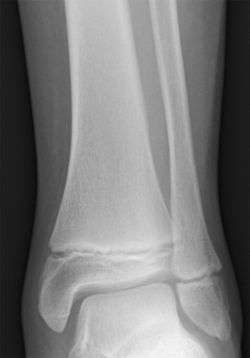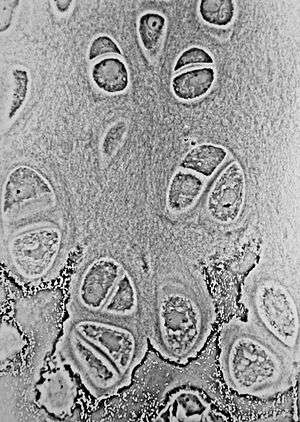Epiphyseal plate
| Epiphyseal plate | |
|---|---|
 | |
 Light micrograph of epiphyseal plate showing the hypertrophic zone with its typical chondrocytes, matrix and three zones: maturation (top), degenerative (middle) and provisional calcification (bottom). | |
| Details | |
| Identifiers | |
| Latin | lamina epiphysialis |
| TA | A02.0.00.020 |
| FMA | 75427 |
The epiphyseal plate (or epiphysial plate, physis, or growth plate) is a hyaline cartilage plate in the metaphysis at each end of a long bone. It is the part of a long bone where new bone growth takes place; that is, the whole bone is alive, with maintenance remodeling throughout its existing bone tissue, but the growth plate is the place where the long bone grows longer (adds length).
The plate is found in children and adolescents; in adults, who have stopped growing, the plate is replaced by an epiphyseal line. This replacement is known as epiphyseal closure.
Structure
Development
Endochondral ossification is responsible for the initial bone development from cartilage in utero and infants and the longitudinal growth of long bones in the epiphyseal plate. The plate's chondrocytes are under constant division by mitosis. These daughter cells stack facing the epiphysis while the older cells are pushed towards the diaphysis. As the older chondrocytes degenerate, osteoblasts ossify the remains to form new bone. In puberty increasing levels of estrogen, in both females and males, leads to increased apoptosis of chondrocytes in the epiphyseal plate.[1] Depletion of chondrocytes due to apoptosis leads to less ossification and growth slows down and later stops when the entire cartilage have become replaced by bone, leaving only a thin epiphyseal scar which later disappears.[2]
Histology
The growth plate has a very specific morphology in having a zonal arrangement.
| Epiphyseal plate zone (from epiphysis to diaphysis | Description |
|---|---|
| Zone of reserve | Quiescent chondrocytes are found at the epiphyseal end |
| Zone of proliferation | Chondrocytes undergo rapid mitosis under influence of growth hormone |
| Zone of maturation and hypertrophy | Chondrocytes stop mitosis, and begin to hypertrophy by accumulating glycogen, lipids, and alkaline phosphatase |
| Zone of calcification | Chondrocytes undergo apoptosis. Cartilagenous matrix begins to calcify. |
| Zone of ossification | Osteoclasts and osteoblasts from the diaphyseal side break down the calcified cartilage and replace with mineralized bone tissue. |
A mnemonic for remembering the names of the epiphyseal plate growth zones is "Real People Have Career Options," standing for: Resting zone, Proliferative zone, Hypertrophic cartilage zone, Calcified cartilage zone, Ossification zone.[4] The growth plate is clinically relevant in that it is often the primary site for infection, metastasis, fractures and the effects of endocrine bone disorders.

Clinical significance
Defects in the development and continued division of epiphyseal plates can lead to growth disorders. The most common defect is achondroplasia, where there is a defect in cartilage formation. Achondroplasia is the most common cause of dwarfism.
Salter–Harris fractures are fractures involving epiphyseal plates and hence tend to interfere with growth, height or physiologic functions [5].
Osgood-Schlatter disease results from stress on the epiphyseal plate in the tibia, leading to excess bone growth and a painful lump at the knee.
Other animals
John Hunter studied growing chickens. He observed bones grew at the ends and thus demonstrated the existence of the epiphyseal plates. Hunter is considered the "father of the growth plate".[6]
See also
References
- ↑ Zhong, M; Carney, DH; Boyan, BD; Schwartz, Z (January 2011). "17β-Estradiol regulates rat growth plate chondrocyte apoptosis through a mitochondrial pathway not involving nitric oxide or MAPKs.". Endocrinology. 152 (1): 82–92. PMID 21068162. doi:10.1210/en.2010-0509.
- ↑ "Skeletal System / Bone Development and Growth". Archived from the original on 2008-07-09. Retrieved 2008-07-10.
- ↑ Ovalle, William K.; Nahirney, Patrick C. (2007). Netter's essential histology : with Student consult online access (1st ed.). Philadelphia, Pa.: Elsevier Saunders. ISBN 9781929007868.
- ↑ "Medical Mnemonics". Archived from the original on 2012-04-20.
- ↑ Mirghasemi, Alireza; Mohamadi, Amin; Ara, Ali Majles; Gabaran, Narges Rahimi; Sadat, Mir Mostafa (November 2009). "Completely displaced S-1/S-2 growth plate fracture in an adolescent: case report and review of literature". Journal of Orthopaedic Trauma. 23 (10): 734–738. ISSN 1531-2291. PMID 19858983. doi:10.1097/BOT.0b013e3181a23d8b.
- ↑ "Growth Plate (Physeal) Fractures". EMedicine.com. Retrieved 2008-01-15.
External links
- Normal bones at GetTheDiagnosis.org, showing the development of epiphyseal plates for different ages and bones.
| Wikimedia Commons has media related to Epiphyseal plate. |